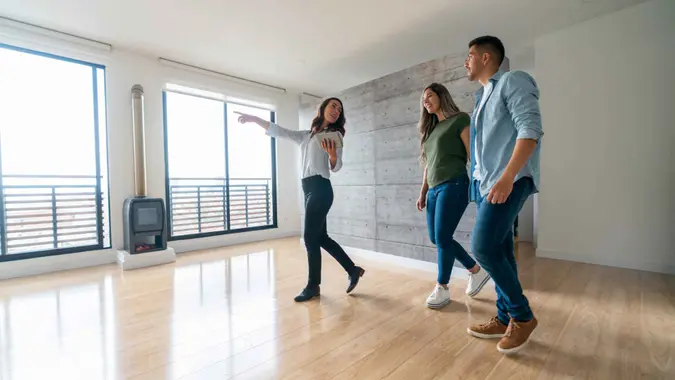Is Rent-To-Buy the Next Hot Market? Wall Street Thinks So

Commitment to Our Readers
GOBankingRates' editorial team is committed to bringing you unbiased reviews and information. We use data-driven methodologies to evaluate financial products and services - our reviews and ratings are not influenced by advertisers. You can read more about our editorial guidelines and our products and services review methodology.

20 Years
Helping You Live Richer

Reviewed
by Experts

Trusted by
Millions of Readers
Private equity powerhouse Blackstone recently poured $6 billion dollars into one of the biggest bets on suburbia in recent history. In July of 2021, Blackstone purchased America’s largest rent-to-buy (RTB) company, Home Partners, which owns 17,000 houses across the country. The rent-to-buy model has been around for years, but with Main Street now putting real money into the rent-to-purchase space, it could shift the consumer real estate market — and change the path to homeownership for average Americans.
The model is simple enough. Companies gobble up thousands of homes and put them on the market as “rent-to-buy” — meaning you enter the home as a renter, but with the option to buy the property outright from the owner — or owning company — at a future date.
Rent-to-Buy Works for Investors and Would-Be Homeowners
With skyrocketing demand for homes and waning inventory, the rent-to-buy model became very popular during the pandemic. President of digital real estate platform Home Qualified, Ralph DiBugnara, told GOBankingRates in a note he believes that investment banks are betting on the rent-to-own model because of the increased focus on single-family home rentals, as well as the expressed strategy to make a higher rate of return on related investments.
The return on investment typically favors the investor. In these kinds of arrangements, a portion of the renter’s monthly rent goes towards a down payment on the home. The price at which the home could be sold to the renter is agreed upon beforehand and the percentage of your rent that goes towards the actual down payment is agreed upon in the contract. It is important to note that the monthly rent a renter pays in some of these types of arrangements is higher than the actual market value (meaning what a normal renter would pay to simply rent the home).
The percentage of rent that goes toward a down payment in such an arrangement depends on the specifics laid out in any attached contract. To reiterate, the monthly amount paid by the renter is higher than fair market value, as the extra money goes toward an eventual down payment. This arrangement can be a benefit to a would-be homeowner who wants to slowly save for a home while actually living in it, but it comes with risk. Rocket Mortgage says the biggest disadvantage of rent-to-own homes is that you will forfeit any money you paid in rent to the homeowner should you choose to not buy the home after all.
Home Partners offers programs with a little more flexibility, where there are fixed rental rate and purchase options for a period of time. Through their Choice Lease program, there are no financial penalties or non-refundable deposits for residents who choose not to purchase the home. Their model is more of the standard lease model, and through Choice Lease, offers 10% lower rent than market rates. You need to apply and meet certain income eligibilities for the Choice Lease program. Their standard lease model provides rents at market value.
“If the cost of the rent-to-own option is not based around a higher-than-market rate on rent or end financing of a home, then it should be considered as an option to buy real estate,” DiBugnara adds. He also recommends taking a look at home-buying grants or city and state programs that help first-time homebuyers first.
Real Estate Inventory Still Presents Problems for the Housing Market
The past two years have shown that affordability has not necessarily been the problem for home buyers, but rather inventory.
Said housing shortage has been largely caused by a population exodus from city centers to suburbia during the pandemic. Suburban homes were selling faster than buyers had a chance to even mull over their decisions, and well above asking price.
The housing market of 2021 will likely go down in history as one of the most frenzied real estate markets ever. Crystal Sunbury, senior real estate analyst with audit, tax, and consulting company RSM, detailed to GOBankingRates that the median price for a home increased 13.9% from November 2020 to November 2021 — to $353,000 — with homes selling in 18 days on average.
The preferences of an aging millennial population have also shifted market preferences, and Wall Street is taking notice. Paraag Sarva, CEO of renter-focused financial services company Rhino, says Millennials and Gen Zers do not see traditional homeownership as a realistic or responsible financial decision anymore and that “there are other ways to accumulate wealth that were unavailable to their parents, such as hitting the stock market via accessible mobile apps and investing in alternative currencies.” Alongside the surging price of home purchases, the price of rent also rose this year, Sarva notes.
“With the cost of rent dramatically increasing over the past year or so, we can expect to see the real estate market continue to follow a trend of renting-to-buy,” he concluded.
The supply of single-family homes dwindled during the pandemic, but that does not mean demand for them has waned. “Single-family home rentals have become more popular than ever post-COVID. Many more people want either more space for work or school from home. Some are also living like nomads with the benefits their new virtual jobs provide them,” DiBugnara adds. This continued need for single-family homes suggests that the rent-to-buy market has the potential to stick around — and to expand. If Blackstone’s recent $6 billion bet is any indication, other investment firms may soon follow suit.
For the average consumer, this circumstance could mean finding alternative ways of landing their dream home in the next couple of years. While the home you might have wanted last year could have gotten snatched up in less than a month, with a rent-to-buy option you might be able to find what you are looking for more easily.
For qualified buyers, such a scenario could potentially offer more options — perhaps even an opportunity to “try the home on for size” before making a solid commitment. If rents remain elevated or continue to increase, then the difference between rent paid on a regular home versus the added equity payment in a rent-to-buy arrangement might be modest enough to make rent-to-buy an attractive value proposition.
More From GOBankingRates
- One-Third of People Have $100 or Less in Their Checking Accounts, Survey Shows — Here’s How Much Experts Say You Should Actually Have
- Gen Z and Millennials Favor National and Online Banks, Survey Shows — What Does That Mean for the Future of Credit Unions?
- How to Easily Add $500 to Your Wallet This Month
- 16 Effective Tips and Tricks To Help You Save Money In 2022
 Written by
Written by  Edited by
Edited by 

























